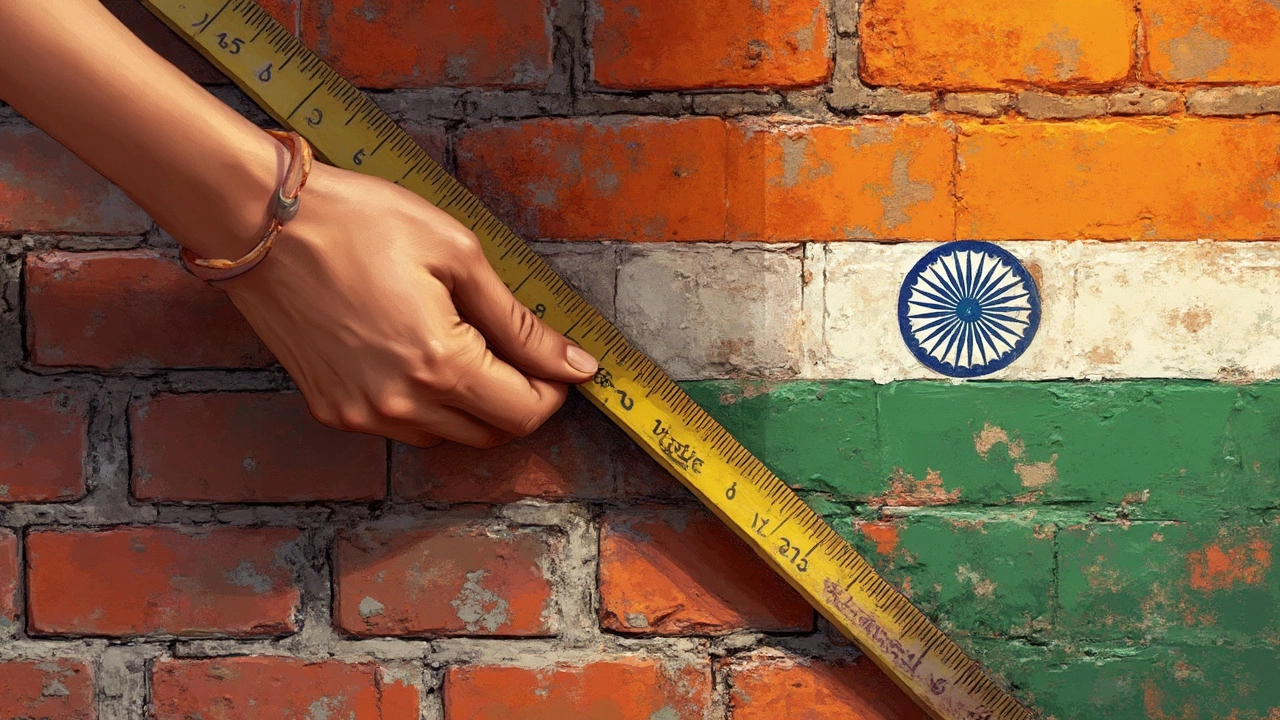The 3 4 5 method is all about making sure your angles are spot-on, specifically those crucial 90-degree angles in construction. Ever set up a foundation or a wall, and it feels a little off? This method can help you spot-check and get it right without fancy tools. It's tried-and-true and relies on a simple math principle: the Pythagorean theorem.
Imagine a triangle with sides measuring 3, 4, and 5 units. What's cool here is that it automatically forms a right angle, giving you a quick and reliable way to check your work when setting out a site or making sure things are lined up correctly. All you need is a tape measure and a bit of string or stakes to visualize the setup.
So why is this important? Well, in construction, accuracy is everything. A minor misalignment can ripple into more significant issues down the road. With the 3 4 5 method, builders have a straightforward technique to get things right from the start, saving time and potential headaches later on. Stick around to learn how you can apply this in your projects and avoid common pitfalls!
- Introduction to the 3 4 5 Method
- Why Use the 3 4 5 Method
- Step-by-Step Process
- Common Mistakes to Avoid
- Practical Tips for Builders
- Real-World Applications
Introduction to the 3 4 5 Method
When you're diving into building construction, the idea of creating perfect right angles might sound more complicated than it is. Enter the 3 4 5 method. It's a game-changer for builders who want precision without a heavy reliance on expensive gadgets.
The magic behind it is rooted in basic geometry. According to the Pythagorean theorem, in any right-angle triangle, the square of the length of the hypotenuse (the longest side) is equal to the sum of the squares of the other two sides. So, for a triangle with sides measuring 3, 4, and 5 units, this naturally forms a right angle. What's not to love?
This method isn't just some theoretical construct. It has been used for ages—dating back to Ancient Egypt when surveyors needed accuracy for their monumental structures. It's still used in modern construction across the world because it works and is easy to apply.
Here's a quick guide on how you use it. Mark one side of your line with 3 units and the other with 4 units, forming a rough 'L' shape. Measure 5 units for the diagonal connecting them. If it matches perfectly, you're looking at a flawless 90-degree angle.
- No fancy tools needed, just a tape measure.
- It's fast, and you can get multiple checks done in no time.
- The accuracy ensures your foundation or walls are spot-on, sparing headaches from structural issues later on.
All these advantages make the 3 4 5 method an essential trick in the builder’s toolkit, especially for anyone working in commercial construction. It's a simple technique, but its impact can be significant when precision is the name of the game.
Why Use the 3 4 5 Method
Using the 3 4 5 method in construction is like having a trusty sidekick. It’s crucial because getting the layout correct sets the stage for everything else. If you're laying out a foundation or checking wall angles, starting with precise measurements can prevent costly mess-ups later. It's a proven method that’s been used for ages because it simply works.
One of the main perks of this method is its sheer simplicity. You don’t need fancy gadgets or expensive tools—just a good old tape measure and maybe some string. It’s all about forming a triangle where the three sides measure 3, 4, and 5 units respectively. The longest side, naturally, should be 5. When you set it up right, this triangle will give you that perfect 90-degree angle every time.
The beauty of the 3 4 5 method is in its accuracy. Even the best builders know that eyeballing things isn’t always reliable. With this method, you’ve got the kind of precision that ensures everything is aligned as it should be, which is especially vital in commercial construction where the stakes are high.
Here’s a quick summary of the steps:
- Measure one straight line, making sure it's 3 units long.
- Measure another line at the end of the first, stretching it 4 units in a different direction.
- If all’s good, the diagonal (the hypotenuse, if we're getting technical) between them should be 5 units, proving you’ve got a right angle there.
While it’s straightforward, it’s also adaptable. You can scale it up to larger projects by simply multiplying each side by the same number. Double each measurement for a bigger scale, keeping the proportions. There you have it, a method that's not only practical but adaptable too!
Step-by-Step Process
Getting the hang of the 3 4 5 method is pretty straightforward. Here's how you can put this technique to use in your construction projects.
- Prepare Your Tools: Grab a tape measure, some string, or stakes. These are your best buddies for marking out your site.
- Mark the First Side: Start with one side of your triangle. Measure and mark a straight line that is 3 units long (this could be meters, feet, or any consistent unit of measure).
- Mark the Second Side: From one end of the first line, measure out a straight line that is 4 units long. Use a stake to mark this spot.
- Create the Third Side: Now, measure the diagonal from the end of your 4-unit line to the end of your 3-unit line. It should measure exactly 5 units. If not, recheck your lines for straightness and adjust as needed.
- Check the Angle: Once your triangle sides meet these measurements, you've got yourself a perfect right angle. This means your corner is precisely 90 degrees.
By following these steps, you can ensure that your building starts on a solid and accurate foundation. And remember, while this tool is simple, its precision is key to keeping everything aligned.
Why go through the hassle of double-checking? Because even a small error in your angles can turn into big problems, like walls not meeting correctly or uneven floors.

Common Mistakes to Avoid
In the world of building construction, especially when using the 3 4 5 method, accuracy is king. However, mistakes can creep in if you're not paying attention. Here are some common goof-ups to watch out for.
First off, don't assume you can eyeball the measurements. Precise distances are a must here. Incorrectly measuring the lengths of 3, 4, and 5 units can throw off the entire idea of creating that perfect 90-degree angle. Always use a reliable tape measure, and double-check your work.
Another mistake is overlooking the surface you're working on. Uneven or sloped surfaces can mess with your measurements. Make sure the ground is level before setting your points.
Also, keep an eye on whether you're working in feet, meters, or any other unit of measure. Mixing up units can lead to costly errors.
Using worn-out tools is also a common oversight. A stretched-out tape measure or loose stakes can compromise your results. Check your gear regularly and replace any tools that have seen better days.
Avoid these common pitfalls, and your use of the 3 4 5 method will go a lot smoother. Remember, a little attention to detail now can save a whole lot of frustration later!
Practical Tips for Builders
Whether you're a seasoned pro or just starting out in the world of building construction, using the 3 4 5 method can be a game changer for your projects. Here are some tips to get the most out of this technique:
- Preparation is Key: Before you start, double-check your measurements. Make sure your measuring tape is accurate and your stakes or markers are stable. When you're counting on 3 4 5 to set your angles, accuracy is crucial.
- Use Quality Materials: For best results, use a non-stretchable string or a sturdy measuring tape. Flimsy materials can throw off your measurements, leading to errors.
- Measure Twice: We've all heard it—measure twice, cut once. This philosophy applies here too. Double-checking your measurements reduces the chance of mistakes.
- Check for Obstacles: Before swinging that tape around or driving in a stake, look for anything that might get in the way like rocks, debris, or uneven ground. These can skew your layout.
- Practice Regularly: Like most skills, the more you do it, the better you get. Try practicing the 3 4 5 method in different settings to get comfortable with it.
If you're keen on seeing how others use this technique, here's a quick look at its effectiveness:
| Project Type | Success Rate (%) | Time Saved (hours) |
|---|---|---|
| Commercial Buildings | 95 | 10 |
| Residential Housing | 90 | 8 |
| Public Infrastructure | 92 | 12 |
These numbers show how relying on the 3 4 5 method can significantly boost efficiency and accuracy in professional projects. Adopting it can really help streamline your workflow and reduce costly mistakes.
Real-World Applications
Let’s dive into how the 3 4 5 method is used in real-life construction projects. This technique is a staple in the toolkit of many builders, forming a backbone of practical knowledge in building construction.
One key application is during the layout of building foundations. Ensuring that corners are a perfect 90 degrees is crucial; it prevents problems when fitting walls and alignments later on. Builders typically measure three units along one side and four along the other, and the diagonal should be five if it's correct. This helps confirm that the edge forms a right angle.
Another common use is in setting out partition walls in commercial buildings. You know, when spaces need clear delineations, particularly in office spaces, getting those walls aligned just right is a big deal. It’s not just about aesthetics—it’s about maximizing space and ensuring everything fits snugly.
Additionally, the method is handy when laying out parking lots or patios where precision in the layout can save time. You might think, “A parking lot?” but yes! Getting those boundaries correct means better-fitted lines that don't need redoing, which is a huge timesaver.
This technique also comes into play during roof construction. Ensuring that trusses align perfectly not only saves on materials but also contributes to the structural integrity of the building.
In many developing regions, where high-tech tools aren't always available, the 3 4 5 method offers a low-cost yet effective solution for achieving precise construction results. It’s pretty impressive how such a simple principle helps avoid costly re-dos and accidents in these environments.
Here's a comparison of time efficiency:
| Method | Average Time Saved |
|---|---|
| 3 4 5 Method | Up to 20% less time compared to no preliminary angle checks |
| Modern Laser Tools | Up to 25% less time, but more costly |
So, whether you're a seasoned pro or a novice learning the ropes in commercial construction, the 3 4 5 method remains a trusty friend, ensuring angles are right and preventing hiccups down the path.






